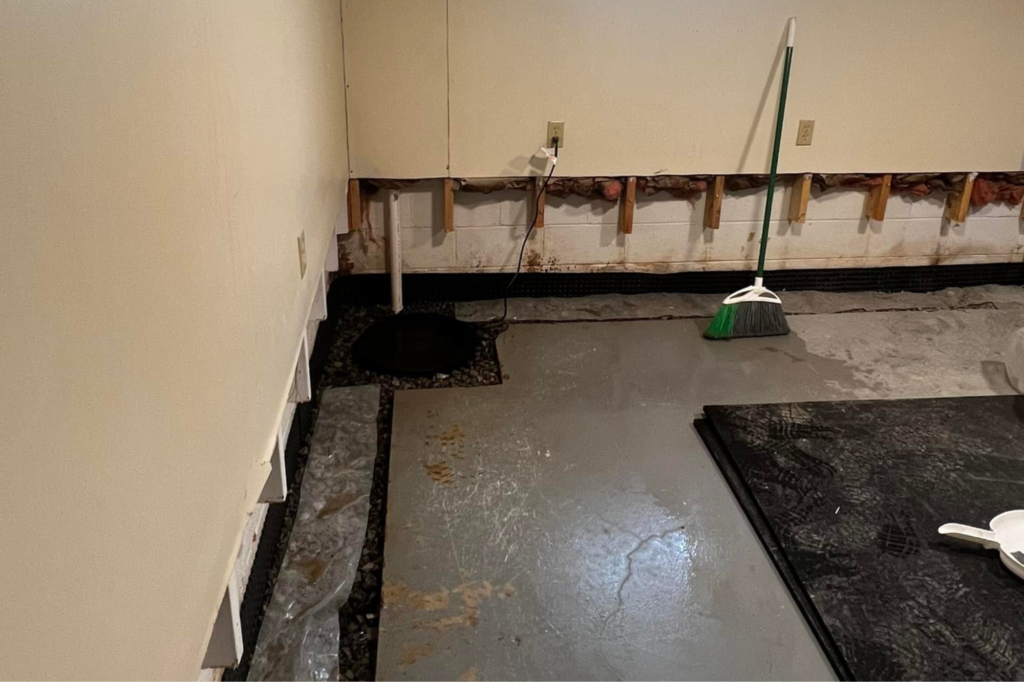You’re facing a wet basement, and it might be due to hydrostatic pressure forcing water through foundation cracks or inadequate waterproofing. To solve this, make sure proper property grading is done to direct water away from your foundation and check downspouts, extending them 6-10 feet. Inspect and clean gutters regularly to prevent overflow. Repair foundation cracks with hydraulic cement or foam injections after identifying their severity. Enhance basement waterproofing with sealants and consider installing a French drain system. Regular checks on sump pumps are essential. Address these areas, and you’ll uncover more solutions and preventative measures.
Key Takeaways
- Hydrostatic pressure forces water through foundation cracks, often caused by poor drainage or foundation settling.
- Inspect and clean gutters regularly to prevent debris buildup and overflow that can lead to basement water issues.
- Extend downspouts 6-10 feet away from the home to direct water away from the foundation effectively.
- Apply high-quality waterproofing sealant on interior walls and consider installing a French drain system for optimal water diversion.
- Repair foundation cracks using hydraulic cement and monitor for new cracks indicating ongoing movement or stress.
Common Causes of Wet Basements
Although a wet basement can seem like an unavoidable nuisance, understanding its underlying causes is important for effective prevention and repair. The common causes of wet basements stem from various factors, including hydrostatic pressure and groundwater seepage. When water pressure builds in the soil surrounding your basement, it can force its way through cracks in the foundation or porous concrete, leading to moisture infiltration.
To counteract this, basement waterproofing solutions like applying sealants or membranes on your basement walls can be effective.
Foundation cracks are another significant contributor to basement moisture. These cracks can result from settling, temperature changes, or the aforementioned hydrostatic pressure. Even tiny cracks can permit substantial water infiltration, so sealing them with hydraulic cement is essential in your basement waterproofing strategy.
Additionally, poorly installed or outdated waterproofing systems can exacerbate moisture problems. Signs of failing systems include damp walls, musty odors, or peeling paint.
It’s important to assess and update these systems to keep your basement dry. Finally, high indoor humidity and condensation can mimic external leaks. Addressing these issues with proper ventilation and dehumidification guarantees that your basement remains a dry and healthy space.
Poor Drainage Solutions
When dealing with poor drainage solutions, it’s vital to understand how external water management directly influences basement dryness. Without proper drainage, water can pool around your home’s foundation, leading to water infiltration and a wet basement.
To fix this, you must make certain your property is graded correctly and slopes away from your house. This prevents water from collecting near the foundation and seeping into the basement.
One effective strategy is to extend downspouts at least 6-10 feet away from your home. This directs rainwater far enough from the foundation to avoid saturation.
Additionally, maintaining a basement waterproofing service can help you identify areas that might need attention, such as clogged or misdirected downspouts. Investing in professional advice on how to fix a wet basement might save you time and future repair costs.
Another solution is a French drain system, which effectively channels excess water away from your home. This system involves installing a trench filled with gravel and a perforated pipe to redirect water.
Addressing Gutter Issues
To effectively manage gutter issues, it’s crucial to guarantee your gutters and downspouts are clear and functioning properly. They play an important role in directing water away from your home’s foundation.
Start by regularly inspecting and cleaning your gutters to prevent debris buildup that can cause blockages and overflow. Use a sturdy ladder and protective gloves for safety. Clear leaves, twigs, and other debris, confirming water flows freely.
Check your gutters for sagging sections or leaks. Tighten loose brackets and seal any leaks with silicone-based caulk. These simple maintenance tasks can greatly enhance water diversion efficiency.
Next, verify downspouts are directing water at least 6 to 10 feet away from your foundation. You can use downspout extenders or splash blocks to achieve this. Position them so they slope away from the house to prevent water from pooling near the foundation.
Finally, consider installing gutter guards to minimize debris accumulation, reducing the frequency of cleanings.

Fixing Foundation Cracks
If left unaddressed, foundation cracks can lead to significant water infiltration and structural damage. To effectively repair these cracks, begin by identifying their type and size. Hairline cracks might be superficial, but larger ones could indicate serious issues. Use a flashlight to inspect both the interior and exterior foundation walls for cracks.
Once identified, clean the area thoroughly to remove any debris or loose concrete. For minor cracks, apply hydraulic cement or a polyurethane foam injection. These materials expand to fill and seal the crack, preventing water from entering. Make sure the area is completely dry before application to enhance adhesion and longevity.
For larger or more complex cracks, consider consulting a structural engineer for assessment and repair recommendations. They might suggest underpinning or other structural reinforcements.
Always monitor repaired areas for signs of new cracking, as this could indicate ongoing foundation movement.
Finally, address any external factors, such as poor drainage or hydrostatic pressure, that might be contributing to foundation stress. By taking thorough steps, you’ll protect your basement from moisture intrusion and preserve your home’s structural integrity.
Improving Basement Waterproofing
Addressing foundation cracks is just one part of the equation; enhancing your basement’s waterproofing system is equally important to prevent future moisture issues.
Start by examining the condition of your interior walls. Apply a high-quality waterproofing sealant specifically designed for basement walls. This acts as a barrier against water infiltration and helps maintain a dry environment. Make sure that these sealants are applied to a clean, dry surface for maximum adhesion.
Next, consider installing an interior drainage system, such as a French drain. This system collects water before it reaches your foundation and directs it to a sump pump, which then removes it from your basement. Proper installation is essential, so follow manufacturer guidelines closely or consult a professional.
Additionally, evaluate your sump pump system. Confirm it’s functioning correctly, with a reliable battery backup in place to safeguard against power outages. Regular maintenance checks can prevent unexpected failures.
Lastly, inspect the exterior grading around your home. The ground should slope away from your foundation to effectively direct water away.
Preventative Measures to Implement
When it comes to keeping your basement dry, proactive measures are your best line of defense. Start by inspecting your gutters and downspouts regularly. Make sure they’re not clogged, and direct water at least 6-10 feet away from your foundation.
Proper grading around your home is vital; the ground should slope away to prevent water from pooling near your basement walls.
Seal any cracks in your foundation with hydraulic cement, and consider applying a waterproof sealant on both interior and exterior walls. This creates an additional barrier against moisture infiltration.
Install a sump pump system with a battery backup to remove water during power outages. Regularly test the system to confirm its operation.
Managing indoor humidity is equally important. Use dehumidifiers to maintain moisture levels below 50%, and make certain your basement has adequate ventilation.
For extra protection, install vapor barriers on walls and floors to prevent condensation.
Finally, schedule annual inspections of your home’s drainage and waterproofing systems. These preventative checks can identify potential issues early, saving you from costly repairs.
In Summary
To effectively tackle a wet basement, start by addressing poor drainage and ensuring gutters are clear and functional. Repair foundation cracks promptly to prevent water infiltration. TC Foundation Pros recommends enhancing basement waterproofing with high-quality sealants and installing a reliable sump pump system for added protection. Additionally, grading the landscape away from your home helps direct water flow, reducing the risk of moisture buildup. Implement preventative measures like grading the landscape away from your home. By taking these detailed, solution-focused steps, you’ll protect your home’s structural integrity and maintain a safe, dry environment for your family.
